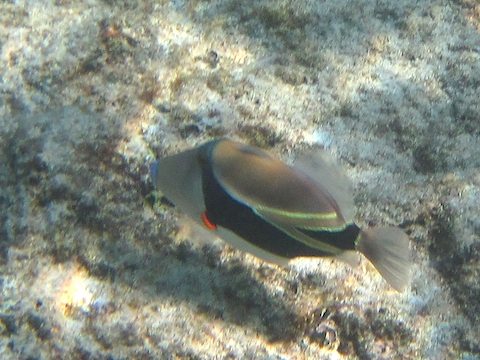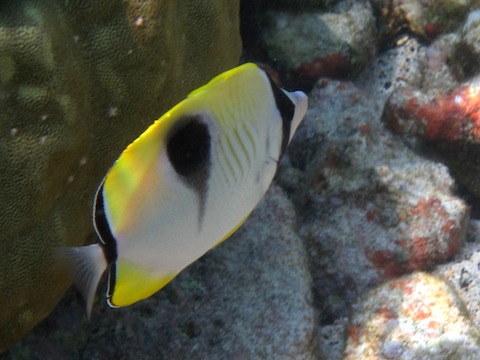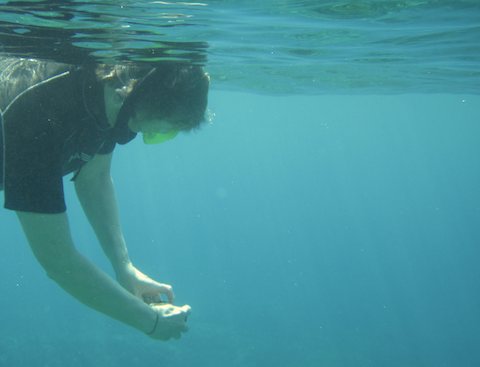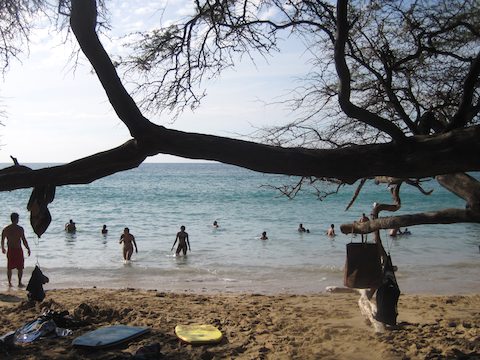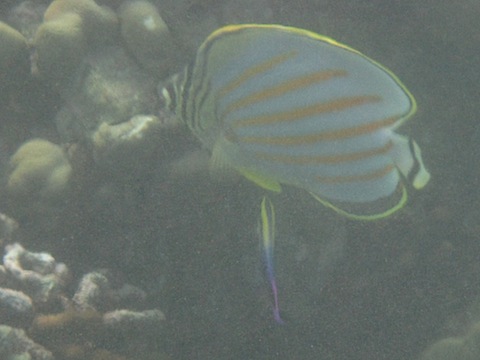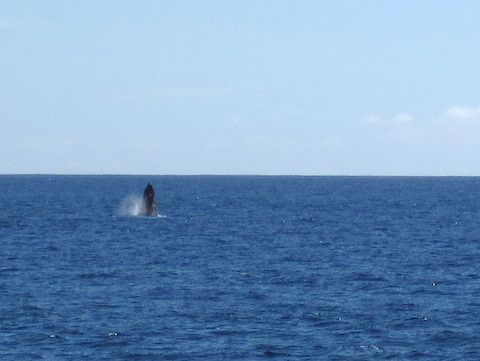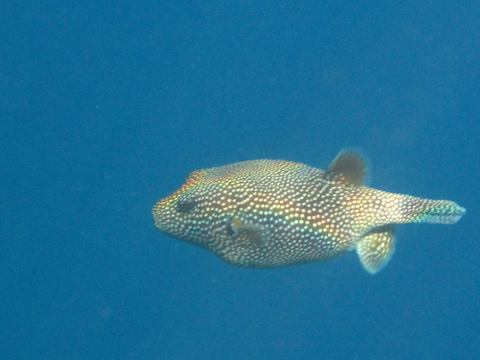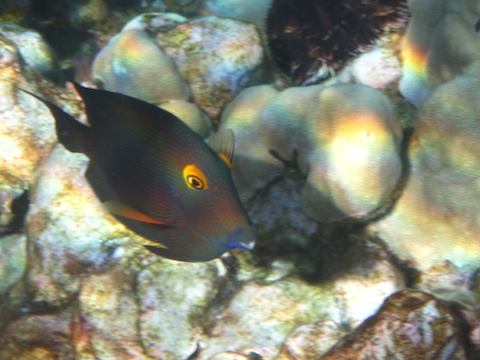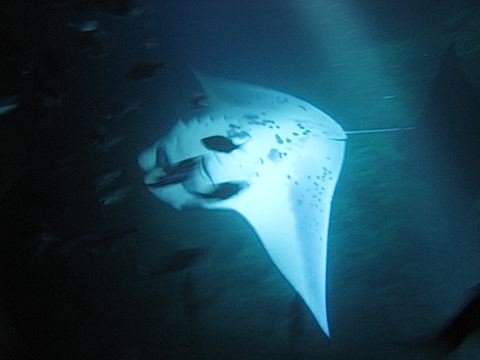Aloha!
Gail and I are back from our 12-day vacation on the big island of Hawaiʻi.
We had a great time. We snorkeled with strikingly colored tropical fish
and manta rays. We saw colorful birds and humpback whales.
We visited historic sites and volcanoes. We ate well and drank Kona coffee,
and lost a couple of pounds in the process.
We decided to go to Hawaiʻi this year because the the Maho Bay Campground,
where we'd stayed during
our previous visits
to St. John in the Virgin Islands, had to close because they lost their lease.
Forced with having to relocate, we thought we would try snorkeling in
a different ocean for a change. We selected the Big Island of Hawaiʻi because
of the numerous locations for good snorkeling on its west coast.
This was our first trip to Hawaiʻi.
During the trip, I took more than 1,360 photos. Not all of them are here.
|
|
Kahaluʻu Beach Park
|
|
We passed the first eight days of our vacation on the west side
of the island near Kailua-Kona. We snorkeled at Kahaluʻu Beach Park,
Honaunau Bay (also called Two Step), Waialea Beach (also called
Beach 69) and Kealakekua Bay near the Captain Cook Monument.
We were impressed by the variety of fish we saw at
Kahaluʻu Beach Park even though it is only five miles from
the center of Kailua-Kona and is crowded with sunbathers,
surfers and other snorkelers.
Kealakekua Bay also was great, though we had to take a boat tour
with Fair Wind II
to get there. The alternative was to hike 1,300 feet down
to the bay on a 2-mile trail, and then back
up again. A bonus of our taking the
boat was that we saw humpback whales on both legs of the trip.
Waialea Beach had lots of fish too, but we got there in mid afternoon on a day
when hazy clouds obscured the sun and after winds had stirred up the
ocean so the water was murky. A photo below shows how murky it was.
Our guidebook (Hawaii: The Big Island Revealed) said that
Paiwai Bay, located just north of the Old Kona Airport Beach Park,
featured exciting snorkeling. We walked the half mile from the park
over jumbled lava boulders and decided that getting into the surging
water amidst the boulders and coral would be too exciting for us.
|
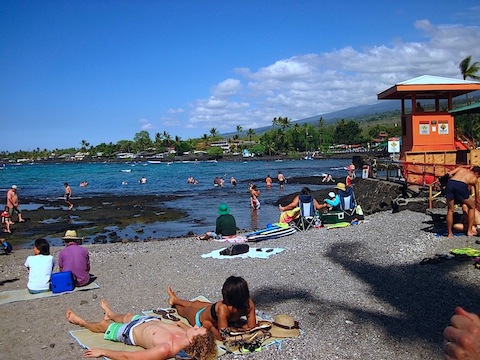
|
Raccoon Butterflyfish at Kahaluʻu Beach
|
Threadfin Butterflyfish with two Yellow Tangs
at Kahaluʻu Beach
|
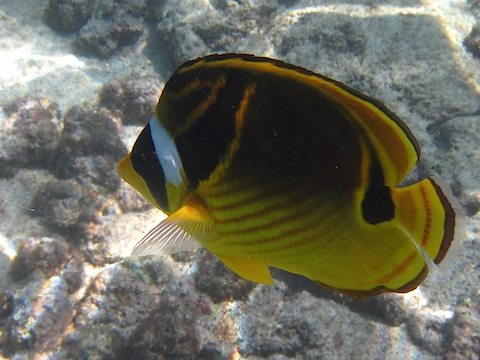
|
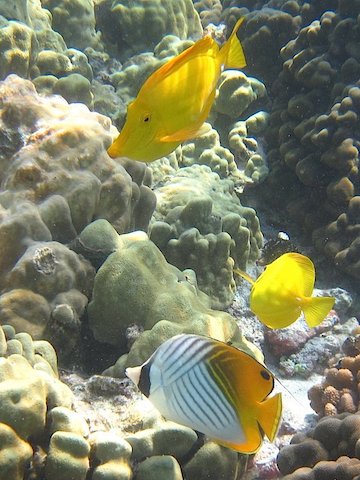
|
We did not spend all of our time in the water. We visited
Puʻuhonua o Honaunau National Historical Park,
Kaloko-Honokohau National Historical Park,
South Point,
the green sand beach
at Mahana Bay, the 420-feet high
ʻAkaka waterfall, Rainbow Falls and more.
Green sand beach lies 2 1/2 long miles past where you would want to drive
a car. We had the option of walking or of riding in the bed of a pickup for
a $10 or $20 fee, depending upon how many passengers were available.
We chose the pickup. It was a jolting, half-hour ride each way.
Temple guardians overlooking Honaunau Bay at the
Pu'uhonua o Honaunau National Historical Park.
|
Petroglyph at the
Kaloko-Honokohau National Historical Park.
|
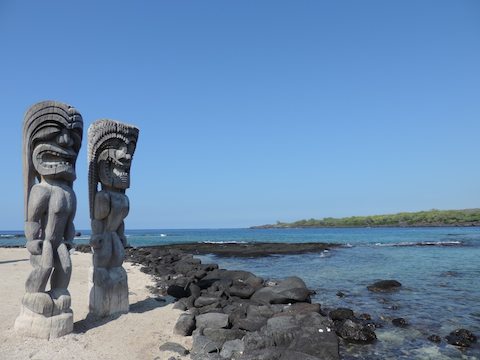
|
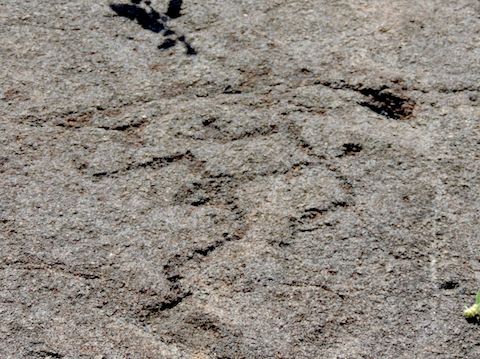
|
Gail and me on the bluff above Mahana Bay.
|
Green sand beach at Mahana Bay, colored by olivine
|
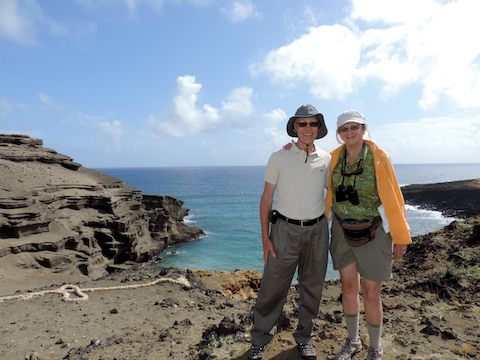
|
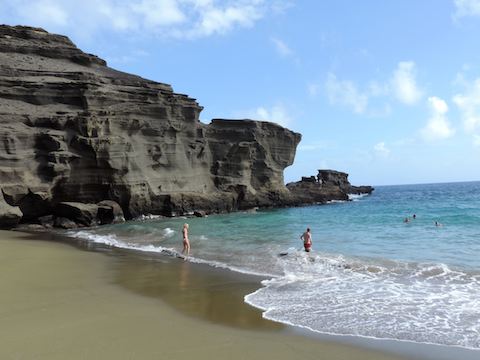
|
|
|
The kitchen area of the great room where we lived
in the Kaloko Mauka district above Kailua-Kona
|
|
On the west side of the island, we stayed in a vacation rental
about 3,000 feet up the side of
Hualalai, an extinct volcano. Evenings and nights were comfortable there
and it was a lot less expensive than at one of the seaside resorts.
A big bonus was that our rental was on the second floor above a workshop
so in the morning we could sit in front of the picture windows, sip our coffee
and watch the birds darting around in the ohi'a-lehua trees.
On the east side we stayed in an
inn
in Volcano Village,
near the 4,000-foot summit of Kilauea volcano.
There our room and the dining lanai were on the second floor,
and we could again watch the forest birds while enjoying our breakfast
of papaya topped with pineapple, macadamia nuts, yogurt and banana.
|
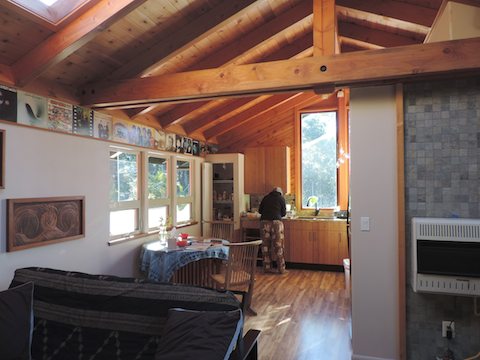
|
We saw colorful birds at the beaches, in the craters and during our walks
through the forests as well as from our breakfast tables.
Most, such as the kalij pheasant shown below, were imported from
other parts of the world.
But we did see some endemic birds, birds occurring nowhere else in the world.
One of them, the ʻapapane, was fairly common in the mid elevation
forests, though usually on the other side of a branch or behind me.
Kalij Pheasant, a non-native bird, that hung around our vacation rental
but also in the Kipukapuaulu in Hawaiʻi Volcanoes National Park
|
An ʻApapane, one of the honeycreepers endemic to Hawaiʻi,
seen from our breakfast table at the Volcano Inn
|

|
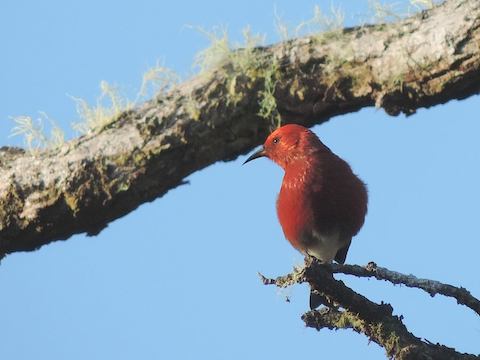
|
An ʻAmakihi, another endemic honeycreeper,
in Hawai'i Volcanoes National Park near the Jaggar Museum.
|
A Nene, the state bird of Hawaiʻi, standing on a lava cliff
above the Pacific Ocean in Hawai'i Volcanoes National Park
|
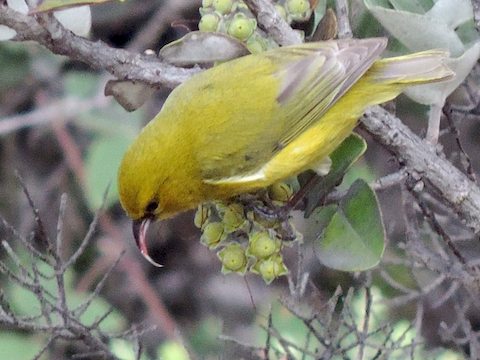
|

|
The Hawaiʻi Volcanoes National Park runs from sea level
to Mauna Loa, 13,677 feet high. The area we visited is centered
on the Kilauea, an active volcano, which is about 4,000 feet high.
We hiked through the Kilauea Iki Crater, a four mile trail going 400 feet
into the crater and 400 feet back up again. In 1959 this crater contained
a lake of molten lava and a fountain of lava, which created
Puʻu Puaʻi, the cinder cone
in the center of the panorama below. Now the lake’s surface has solidified
and the
subsurface lava has cooled, but it is still hot enough that rain trickling
into the rocks emerges as steam from vents in the crater floor.
Kilauea’s Halemaʻumaʻu Crater held a lake of lava
when we visited. Fumes rising from this eruption can be seen
just to the right of Puʻu Puaʻi.
Tourists were not permitted near the crater because of the danger
from the fumes, but the glow of the lava reflected off the fumes
can be seen in a picture I took at night.
Mauna Loa dominates the skyline on the right of the panorama. Getting
to the summit is a multi-day backpacking adventure. We did not try it.

Reflection of molten lava off the fumes coming
from the Halemaʻumaʻu Crater of the Kilauea volcano.
|
Al at Steam Vents above the Kilauea Caldera
|
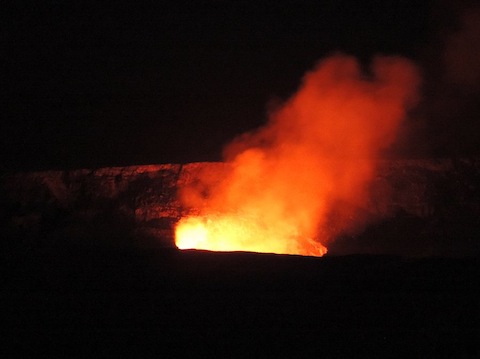
|
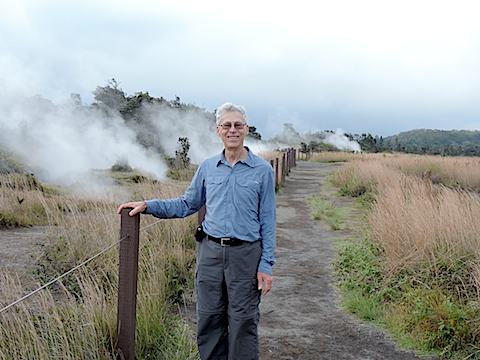
|
End of the Road: where lava buried
the Chain of Craters Road in 2003
|
Holei Sea Arch
|
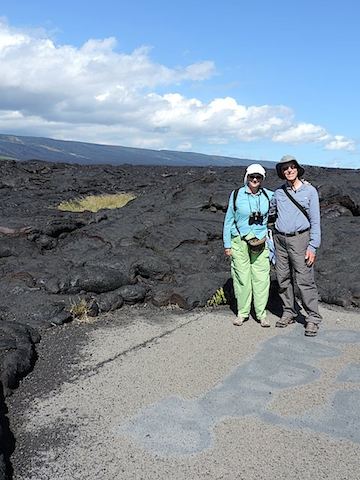
|
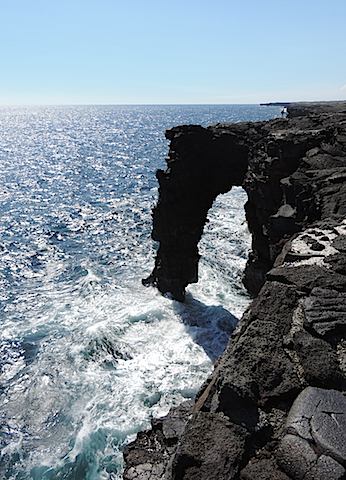
|
After leaving the national park, we drove back to the Kailua-Kona area, stopping
at a black sand beach on the way. On our last day in Kailua-Kona, we visited the
Mountain Thunder coffee
farm, sampling some of the brew and buying some souvenirs.
The Punaluʻu black sand beach
|
A coffee blossom at Mountain Thunder
|
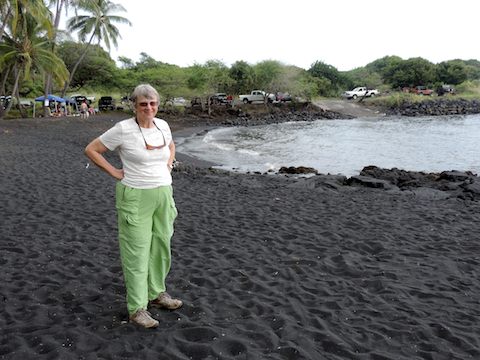
|
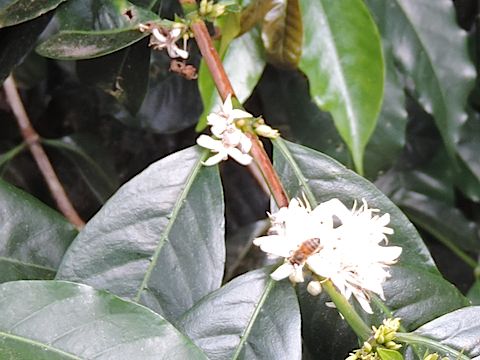
|
|
After 12 days on the island, we had to head home. We took the red-eye flight
Monday night, January 20, but did not get home when expected. Our final
leg, from Charlotte to BWI, was cancelled due to a snow storm, and
we had to spend the night in North Carolina. We did finish our
journey on Wednesday morning.
We left Maryland on January 8 when the
temperature was 7°F, and when we returned it was 7°F again.
Not much progress here!
Aloha!
|
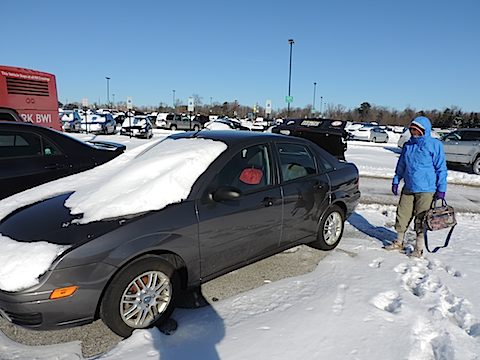
|
Created: 30 Jan 2014; Updated: 31 Dec 2014



